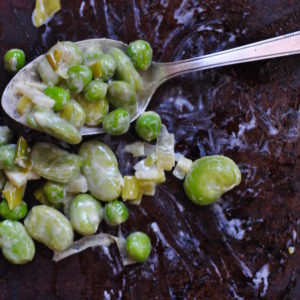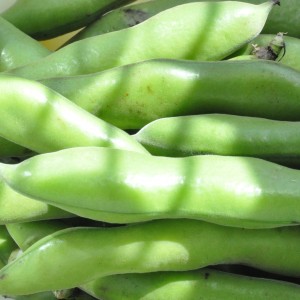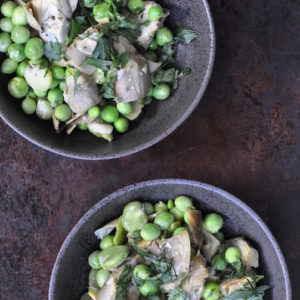Pasta, peas, and proscuitto
Never has writing about food felt more futile, privileged, or frankly ridiculous.
Having said that, capitulate and the bad guys win. We don’t want that. Here are some ways to help:
The American Civil Liberties Union
National Immigrant Justice Center/Immigrantjustice.org
—
Pasta, peas, and prosciutto began as pasta with fava beans and prosciutto. Hoping to share this recipe here, I drove the market, just last week brimming with pliant, otherwordly fava beans. On this day, nary a fava extended an inquiring green finger into the adjacent Blue Lakes. No leathery pods poked the brightly pink Borlottis.

An experienced blogger–say, somebody maintaining a blog for three years or so–immediately moves to the next recipe. Your hostess was struck dumb. (A frequent occurrence these days.) She stood in Berkeley Bowl’s vegetable aisle for a good ten minutes, surrounded by early summer’s gorgeous bounty. You’d think inspiration would be immediate. But no.
Peas, you idiot, her superego finally piped up. Fresh peas will work just as well.

Indeed, peas are more accessible anyway. Fava beans scare people, even those who don’t remember Anthony Hopkins going on about them with a nice Chianti.
Peas it is. Those peas may be fresh at this time of year, but doesn’t mean they won’t be starchy. This makes it difficult for me to give a definite cooking time. Instead I’ll tell you to cook and taste until you think they’re done.
About pasta: people get very involved in which pasta goes with which food. I cannot pretend to know anything of this art. Instead, I’ll tell you round or tubular shapes are best here, to help grab the peas. This pasta, prosaically, is entitled “wagon wheel” and comes from Berkeley Bowl.

Proportions of “stuff” to pasta are tricky. Some people like a lot of meat and veg with their pasta. Others feel pasta should be the star of the show. It must also be mentioned that in Italy, pasta is not a main dish, but a small first course.

Having confessed to the American practice of considering pasta the “meal,” I prepared a pound of pasta, hoping for leftovers, as John needed a packed lunch for an office-related field trip the next day.

No such luck.
Pasta, peas, and prosciutto
Serves 2. Amounts easily increased
16 ounces/1 pound/454 g tubular, rounded or short stubby pasta like Rigatoni, Penne, medium shells, or a shape comparable to the “wagon wheels” pictured
2 tablespoons best olive oil
2-3 medium garlic cloves, peeled and chopped
3 ounces/85 g prosciutto, sliced into slivers
8 ounces/1 cup/250g fresh peas
Salt and pepper to taste
This dish comes together quickly, so it’s your call how you prefer to go about preparing it. If you’re good at multitasking, make the pasta and sauté the prosciutto and peas simultaneously. If you aren’t a multitasker, start with the prosciutto.
Heat the olive oil into large, heavy frying pan over low to medium heat. Add the garlic. Cook gently for about a minute. Add the prosciutto, cooking for a few minutes, letting the fat render a little. Add the peas. Cooking time depends on how starchy your peas are; this may be anywhere from three to ten minutes. Stir ingredients with a spatula and taste peas for doneness. The prosciutto is pre-cooked. We’re just heating it up.
Now get your pasta going. Fill a pot with water and add enough salt to make it really salty. Bring to a rolling boil. Add the pasta. Cook until al dente or however you like your pasta. Drain, but not before reserving a half cup of pasta cooking water; set this aside.
If you are a classy type, you can set a serving bowl in a low oven to warm. If you’re like me, you can set your pasta bowls on the counter and be done with it.
Return drained pasta to the cooking pot. Tip peas and prosciutto into the pot. Stir vigorously. Add reserved pasta water if necessary. Drizzle with more olive oil, if wished. Taste for salt and pepper.
You may now serve in your classy warmed serving bowl or less classy room temperature dishes. A tomato salad is nice on the side, or a green salad. If you aren’t petrified of carbs, good bread is wonderful here. Leftovers, if you have any–we did not–are very good the next day.
Notes:
To makes this dish vegetarian, replace the prosciutto with Parmesan cheese.
Fava beans are also delicious either added to the peas or instead of.
When fresh peas aren’t in season, use frozen.

This has nothing to do with cooking. I took it in San Francisco last weekend.




